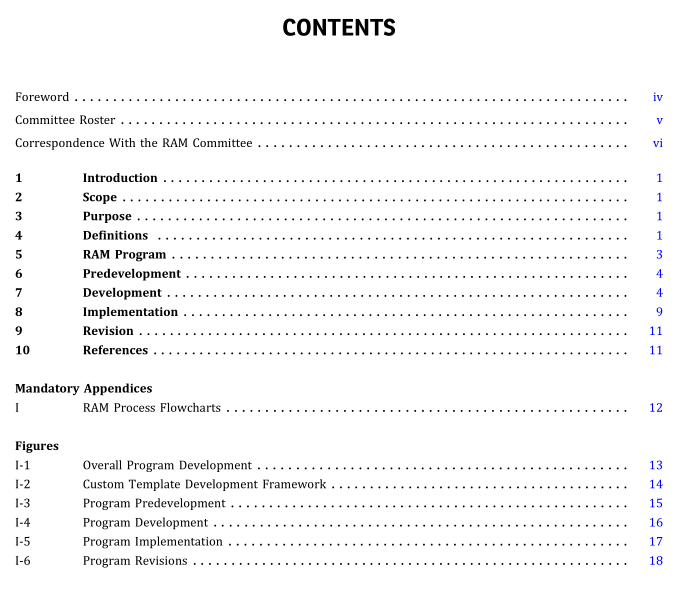ASME RAM-2 pdf download

ASME RAM-2 pdf download Reliability, Availability, and Maintainability Program Development Process for Existing Power Plants
7.6 Custom RAM Templates Customtemplates accountforthe site-specificvariation of an actual component’s installation. Custom templates limit the tasks performed (from standard templates) to just those necessary, and adjust intervals and reorganize tasks to reflect specific plant context, application, and attributes.
7.6.1 Contexts. A contextis a function ofthe attributes ofa component thatmake the component unique, such as location in the plant, service, risk, criticality, environment, and age. Contexts should be grouped by relevant applica- tion. Use of context permits a standard template to be customized.
7.6.2 Sources. Standard templates are used as the basis, or source, for most custom templates; this mini- mizes rework and maintains consistency across all templates. Development of a custom template without the use of a standard template should be considered only where the equipment is unique. In such cases, it is the responsibility of the RAM engineer to consult the VTM and subjectmatterexperts regardingthe specific contextandtheriskassociatedwithusinganon-standard- based template.
7.6.3 Common Context Application. Multiple equip- ment items in a plant often share a common context. Using a common context standardizes work task content across all common instances of a group and is another way to simplify and standardize work. Grouping minimizes customization and variation that would increase program complexity, lower effectiveness, and raise costs. Context may include
(a) duty cycle based on installation usage
(b) installation-dependent environmental stress
(c) functions, provided directly, indirectly, or redundantly
(d) diversity of equipment functions
(e) design margin
(f) other risk functions RAM programs shall identify the common contexts by component type, and then group similar tags that share the same program based on similar context.
A common equipment tag may identify a context group. The group may be identified by a common application, common tag, or similar unique name.
7.6.4 Custom TemplateAttributes. Acustomtemplate should be based on a similar component-type standard template and its attributes. RAM personnel customize standard templates into custom templates by modifying theexistingorprovidingadditional application attributes, based on context. Custom templates share common attri- butes with standardtemplates. Considerations forcustom template application include the following:
(a) Specific failure causes should be individually iden- tified and grouped for common tasks.
(b) Work scopes organize tasks into activity groups that depend upon specific plant design, organization, and tagout boundaries. Work scopes should be
(1) organized independently for tasks and tagouts
(2) based on plantcontextfortagouts, which depend on the plant
(c) Consider operator rounds tasks as generalized work scopes. SeeMandatoryAppendixI,FigureI-2 forinformationon creating a custom template.
8 IMPLEMENTATION Implementation schedules and conducts monitoring, testing, inspection, and maintenance ofcritical equipment to achieve the RAM program goals.
8.1 Work Activity Operations manages control, configuration, and moni- toringofthe plant; maintenance personnel manage equip- ment functionality. Operations typically performs established fixed-routine, short-term tasks for surveil- lance and monitoring in the form of rounds. Maintenance personnel typically perform longer-term planned activities requiringchange-of-state ofequipment using tagout controls under a work order system. Based upon the plant-specific differences (e.g., personnel, equip- ment complexity, management), the context and defini- tions may vary. All RAM program work shall be loaded into rounds or the work order system.
8.1.1 Operators’ Rounds
(a) Physical Rounds. Operators’ rounds are an effective means ofhandling simple, short-duration tasks as part of routine (e.g., daily) activity rather than as part of a work order. Operators physically walk through the plant doing usefulchecksonmostlyrandomfailuresthatresultinlocal condition changes, alerts, and alarms. These physical checks mitigate risk on equipment that is not remotely monitored. Operators’ rounds provide a simple way to dohighlyrepetitiveoperatortasks.Assigningcraftspeople or operators to do the same tasks under a work order would be inefficient and would increase the costs of short-term operational checks.
Consider the following attributes when developing rounds:
(1) Rounds apply to simple, short-interval tasks.









